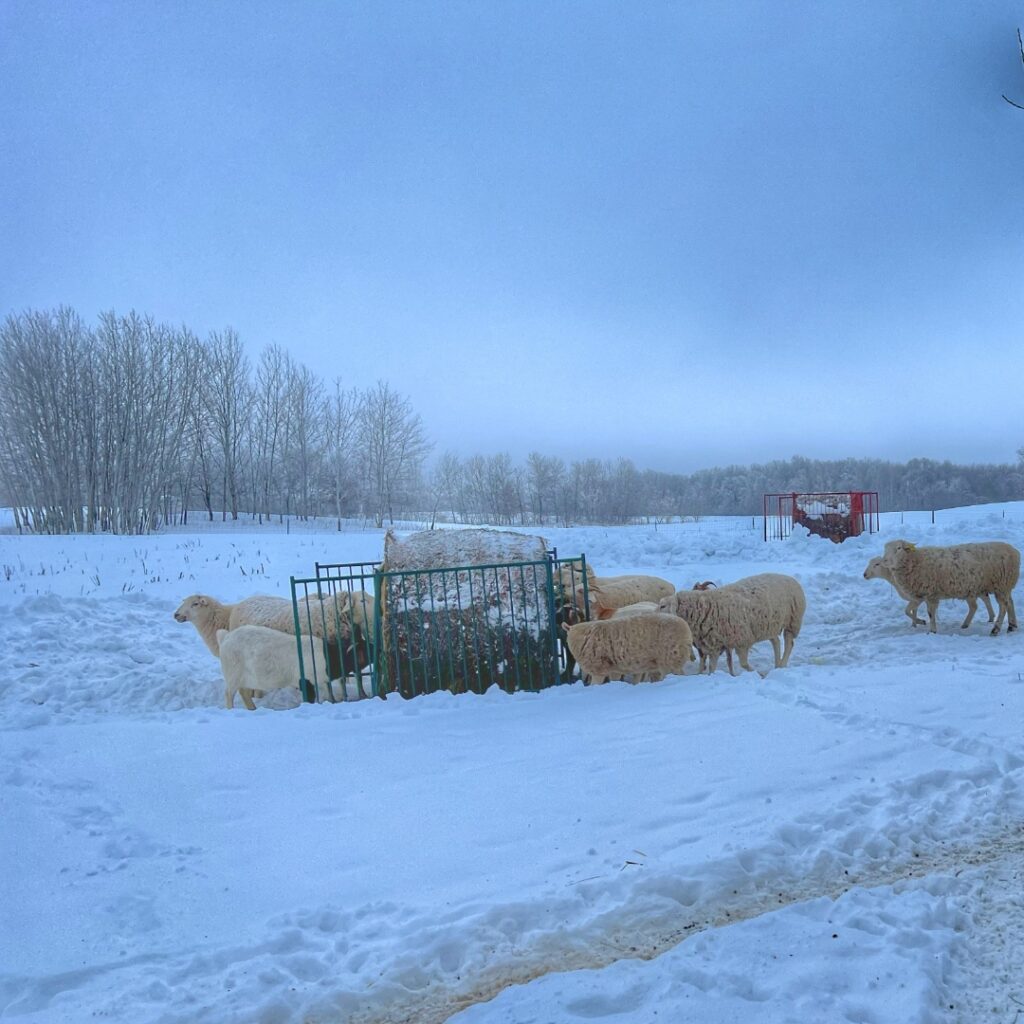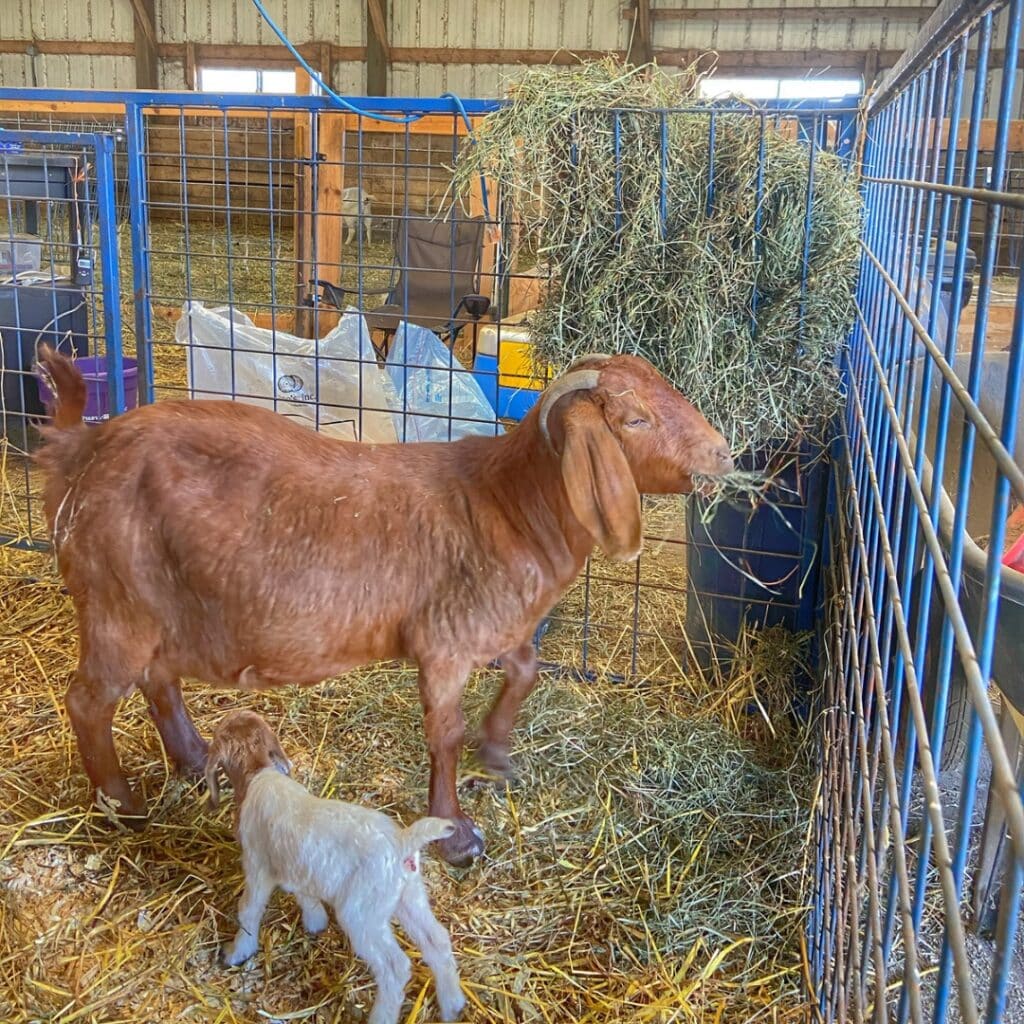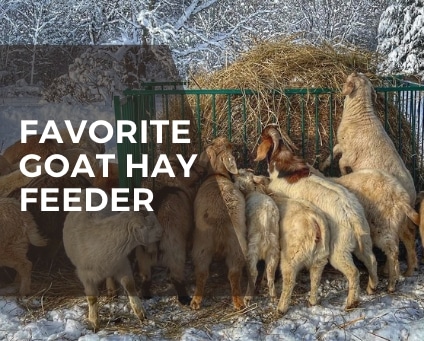Finding the right goat hay feeder is important since it can not only reduce hay waste but also minimize health issues that come with when goats eat off the ground.
In this post I’ll cover why you should be using a hay feeder, factors to consider when choosing a feeder, and our favorite hay feeders we use on our goat farm.
Table of contents
Why you should use a hay feeder
While it can be tempting to not use a hay feeder, especially when you’re just getting started with raising goats, I’d encourage you to take the time to find the right hay feeder for your farm and ranch.
Here are three reasons why you should use a hay feeder:
Reduce hay waste
Anyone who raises goats knows they are notorious hay wasters. Using a hay feeder will help reduce how much hay is wasted. However, not all hay feeders are created equal when it comes to minimizing waste. It is very possible with a hay feeder you may still find your goats are wasting a lot of hay.
Below you’ll find my recommendation on the best goat hay feeder style that produces less hay waste.
Animal health and wellbeing
Feeding goats hay up off the ground in a hay feeder will also reduce the risk of goats infecting themselves with parasites, coccidiosis, or other health issues.
However, goat hay feeders that have wider openings will still allow for excessive hay waste. And, goats, especially kids, may end up eating that waste off the ground. This can possibly lead to health issues with kids, who typically have lower immune systems since they’re still growing.
When feeding goats large hay bales, such as round bales or large squares, without a hay feeder you run the risk of having bales collapse on goats, adults or kids. This is a risk you don’t want to take.
Save money
Even though buying the right goat hay feeder can be costly, in the long-run you’ll save money because of the reduced hay waste. This means you actually have more hay to feed your goats.
When we use our collapsable style panel bale feeder as compared to using no feeder, I’ve noticed a considerable difference in waste.
I’d estimate with the feeder waste is 15% of the bale, while no feeder is closer to 50%. That adds up quickly. For example, a $75 round bale of alfalfa hay, would equate to $11.25 per bale with a hay feeder to $37.50 of hay waste loss per value.
How to choose the best goat hay feeder
When choosing a goat hay feeder you’ll need to consider the context of your farm, as well as when and how you’ll feed the hay to your goats.
Know the needs of your farm
- Inside a barn or outside
- The season you’re feeding hay: winter, spring, summer, fall
- Average rainfall in your area during the time period you’ll feed hay
- The type of bales you’re feeding: small squares, round bales or large squares
- Pens or stalls during kidding season
It’s possible you may need to have different feeders for your goats depending on the situation. For example, when we feed hay during kidding season, we use an individual hanging feeder in kidding pens. However, during the winter months, we are using a collapsible style panel feeder with round bales.
Evaluate the functionality of the feeder
When deciding on a feeder style also consider:
- The opening width of the bars or grates. Can goats with horns get their heads stuck? If it’s larger they’ll also be able to pull out large mouthfuls of hay, usually increasing waste.
- How tall is the feeder? Can younger goats or growing kids still access the hay?
- With larger bales, how easily will the bale be accessible after the bale has been partially eaten? Once the bale is partially eaten does it become a pile of hay rather than in bale form? Sometimes this can be more challenging for goats to eat.
- Can you easily move the feeder?
- How much time do you spend feeding hay with this style feeder?
Different types of goat hay feeders
There are a lot of goat feeder options to choose from. You’ll find better success for feeders designed specifically for goats or sheep over generic all-livestock hay feeders or ones designed for cattle.
Here are a few examples of the types of feeders you might find:
- Over-the-wall or pen-style feeder, typically for individual stalls used during kidding
- Basket or cradle style where the bale is lifted up off the ground
- Collapsible panel feeder
- Rack feeder: v-shaped where goats can eat from both sides
- Bunk style
- Outdoor feeders with roofs
How many hay feeders do you need?
You may need multiple hay feeders, depending on how many goats can eat at a feeder at one time. While your goats may not all be eating hay at the same time, you’ll want to make sure feed is accessible for all animals.
Since goats are herd animals there is usually an existing hierarchy within a herd. This means, younger animals, weaker animals or kids may stay back when the rest of the herd eats or even decide to pick through old hay residue. This can lead to unnecessary health issues.
My favorite goat hay feeder
On our farm, we use collapsible panel-style hay feeders with our goat herd throughout the winter months while we feed round bales of hay. We have been using two different brands (Lakeland Equipment and Ketcham Sheep Equipment) for this style feeder.
This style goat hay feeder is my favorite for several reasons:
- Considerably less hay waste compared to any other hay feeder we’ve used. In fact, when we use them in the barn, we need to buy straw for bedding since we are no longer using hay waste for bedding. That is a much better use of our money!
- These particular feeders have horizontal bars with narrow openings, which also prevents goats with horns to get their heads stuck in the feeder or be vulnerable to being bullied by other goats while eating. Additionally, the narrow opens are why there’s less hay waste.
- They are fairly easy to move around and set up. I can do it by hand, but if we’re moving our feeding location farther away, we can always pick the panels up with the hay spear on the tractor.
- Less hay waste also means reduced time goats are eating off the ground and increasing chances of issues with parasites, among other health issues.
- Eliminate the risk of large bales of hay collapsing on top of goats.
- We are able to practice bale grazing during the winter, which is great for improving the quality of our soil and pasture. It also helps keep our barn cleaner in the winter.

During kidding season we use an over-the-wall style hay feeder to feed slices of small squares of hay. We still get quite a bit of hay waste. I’m still looking for a better option for stall feeding hay where there isn’t as much waste.

Video: Learn about our favorite goat hay feeder
Watch this YouTube video to learn more.
FAQs – Goat hay feeders
Yes, goats need a hay feeder. Without a hay feeder, you’ll greatly increase their risk of being infected by parasites, coccidiosis, or other health issues. Even “basic” hay feeders with wide openings will cause excess hay to drop to the ground, which is still eaten by the goats.
A hay feeder also will save you a lot of money in the long run since goats are horrible hay wasters. The collapsible style hay feeder we use has made hay waste hardly an issue on our farm.
Yes, DIY options for goat hay feeders can work, but you’ll want to make sure you’re looking at ways you can reduce hay waste instead of just saving money on building your own. You could build a collapsible panel-style feeder if you’re good with a welder or have a local welding shop.
Premier 1 Supplies also has decent plans for a DIY bunk-style feeder, which we’ve used inside our barns.

My dad is planning to raise livestock on our farm, such as horses, cattle, and goats, and it seems like he needs hay feeders for them soon to ensure they’re eating properly. It’s good that you mentioned how using hay feeders to feed our livestock will reduce the risk of them getting infected with parasites, coccidiosis, or other health issues they might get when they’re eating off the ground. I’ll take note of this while I look for a supplier to contact for my dad’s hay feeders soon.